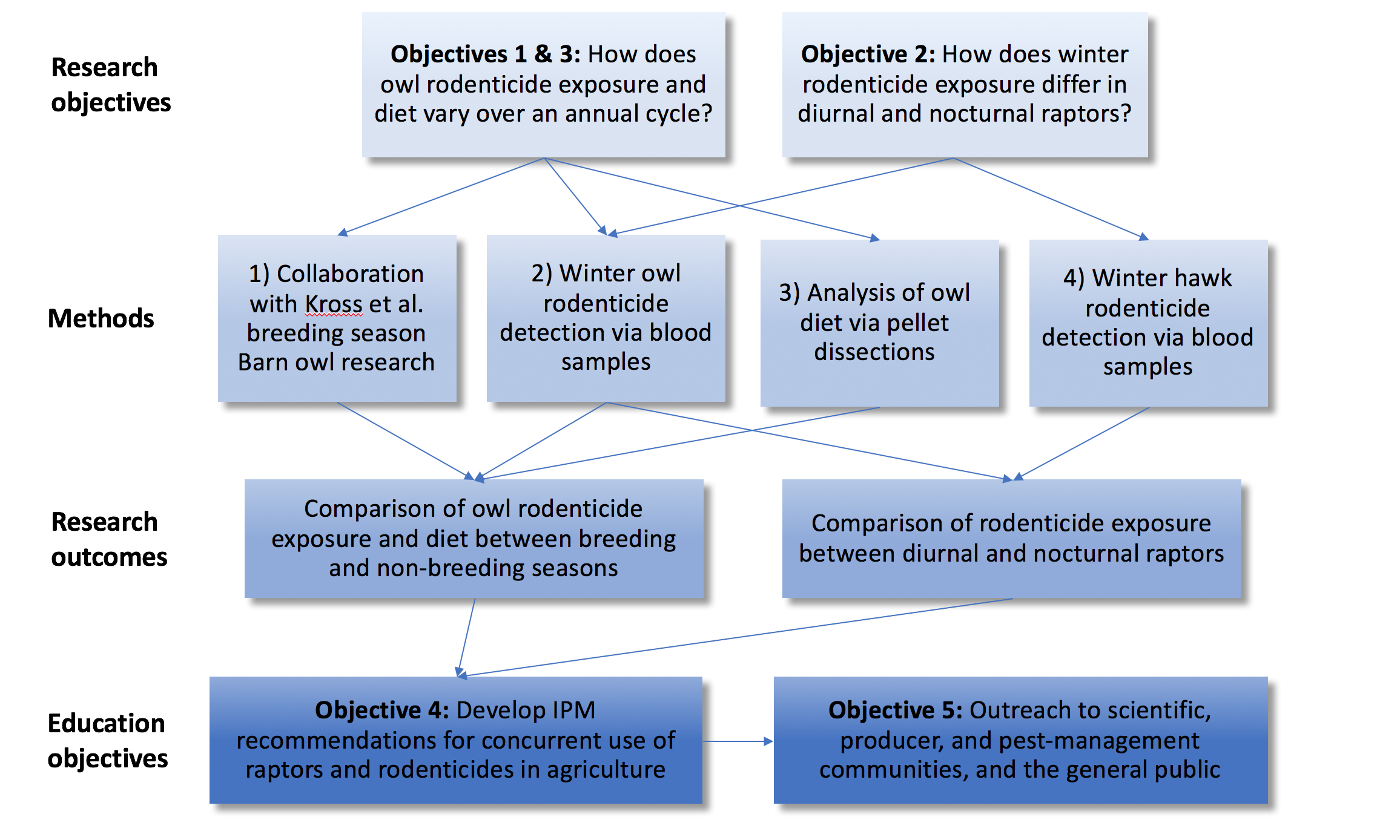Project Overview
Information Products
Commodities
- Agronomic: hay, medics/alfalfa, sunflower
- Fruits: grapes, olives, plums
- Nuts: walnuts
- Vegetables: tomatoes
- Additional Plants: herbs
Practices
- Education and Training: demonstration, display, extension, networking, on-farm/ranch research, technical assistance, workshop
- Natural Resources/Environment: wildlife
- Pest Management: biological control
Proposal abstract:
My project, Natural pest control in a working agricultural landscape: Investigating the impact of rodent control on beneficial hawks and owls, will investigate the frequency of secondary exposure to rodenticides in raptors that provide natural pest control on farms in the Western United States. In the agricultural landscape, the majority of a raptor’s diet consists of rodent pest species that reduce yields and damage infrastructure. Integrated pest management (IPM) strategies for rodent pests frequently incorporate natural pest control provided by raptors, however, rodenticides are often applied concurrently. Rodenticide exposure can cause lethal or sub-lethal secondary poisoning in raptors, ultimately lowering the pest control they provide and increasing farmers’ need for rodenticide use.
We have little understanding of how rodenticide exposure in raptors varies across seasons and between species in agriculture. Furthermore, studies to date have focused primarily on spring and summer months for both understanding the role that raptors play in providing pest control and for monitoring rodenticide exposure—whereas both occur year-round. To address these knowledge gaps, I plan to investigate rodenticide exposure rates in hawks and owls across multiple seasons and varied crop types, and as a function of proximity to rodenticide application sites to answer two critical questions: 1) How does barn owl rodenticide exposure and diet vary over an annual cycle? 2) How do rodenticide exposure rates compare between diurnal and nocturnal raptors?
To accomplish this task, I will collaborate with ongoing barn owl research projects, pest management specialists, raptor biologists, and producers who are interested in data driven research on natural pest control. My ultimate objective is to conduct research that will enhance the understanding of simultaneous use of raptors and rodenticides in agriculture on a year-round basis to help formulate IPM recommendations for producers and to communicate these findings with a wide audience.
Project objectives from proposal:
Objectives:
- Quantify differences in rodenticide exposure frequencies in wintering and breeding barn owls.
- Quantify differences in rodenticide exposure frequencies between wintering diurnal (red-tailed hawks) and nocturnal raptors (barn owls).
- Describe the diet of overwintering barn owls.
- Create stakeholder-verified recommendations for the use of rodenticides and raptors for effective IPM systems for rodent pests, in conjunction with Kross et al. ongoing barn owl–rodenticide research.
- Publicize findings through to the scientific community, producers, and the general public through presentations, publications, and field workshops.
My project will be closely coordinated and in collaboration with an ongoing Western SARE project (SW18-063) investigating impacts of barn owls and rodenticide exposure on sustainable agriculture in the breeding season. My proposed project will add two additional components to the ongoing project and will help provide a complete year-round picture of the interaction of rodenticides and raptors in an agricultural context. First, I will provide a second year of testing for rodenticide exposure in wintering owls, as the ongoing project has funding to look at wintering owls for 1 winter field season. A second winter of exposure rates can help identify year-to-year variation in exposure. Second, I will provide a comparison of exposure rates in a second group of raptors (diurnal red-tailed hawks). Diurnal raptors provide a large portion of pest control services on farms, especially in winter months, and may experience different rodenticide exposure rates than nocturnal raptors.
Figure 2: Flowchart of interaction between project objectives, methods, and outcomes.
